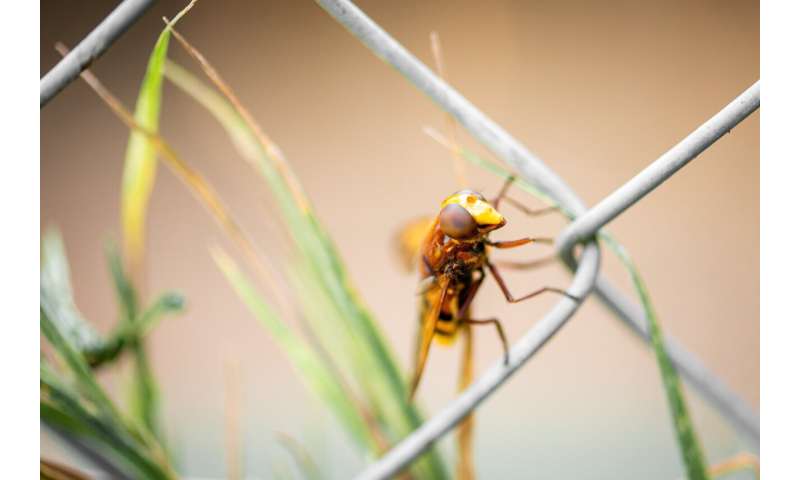Everybody knows about the honeybee Colony Collapse Disorder.
The news stories have subsided, now replaced with a cascade of reports about broader (land) insect decline.
For honeybees, the Varoa mite emerged as a probable prime culprit, in tandem with pesticides (neonicotinoids?) and viruses or other parasites. (Although USDA says no single cause has been definitively proven.)
Then there’s the meme: “windscreen splatter – where did all the bugs go?” That’s really only ‘anecdotal’ from a sciencey pov.
Yet, speculation always existed among activists and fringier science folk that “electro-smog” might have something to do with it. Ie, the pile-on of wifi, telephony, radio, powerline emanations, now including 5G as well. They call all these “non-ionizing radiation.”
Worldwide, the number of insects is decreasing at an alarming rate. It is known that among other causes, the use of pesticides and modern agricultural practices play a particularly important role. The cumulative effects of multiple low-dose toxins and the spread of toxins in nature have not yet been methodically researched, or only in the early stages. Existing research indicates another factor of anthropogenic origin, which might cause subtle adverse effects: the increasingly frequent use of artificial electromagnetic fields (EMF) such as high voltage, mobile telephony and Wi-Fi. The infrastructure of the next generation of mobile communications technologies, 5G, is being deployed without having been previously tested for possible toxic effects. With mankind’s aspirations for omnipresence of technology, even modest effects of electromagnetic fields on organisms might eventually reach a saturation level that can no longer be ignored.
The now-passed heretical biologist Mae Wan Ho tracked and analyzed all this from the early 2000s onward in Science in Society (https://www.i-sis.org.uk/SO_emf.php), eventually putting forward an “Excluded Biology” paradigm around the quantum electrodynamics of the organism – basically that all functions are mediated by water-based quantum coherence. Her cutting-edge conceptual framework helped to make sense of scattered reports of different adverse effects other than from direct heating – which appears to still be the reigning mechanism that scientists prefer to zero in on in EMF / biology / ecosystem studies (presumably because it can easily be measured – and corresponds to an older mechanistic approach, for example: https://www.nature.com/articles/d42473-019-00009-7).
This new German report (http://bit.ly/RFinsectreview2020), from University of Freiburg Masters student Alain Thill, published via an activist group Diagnose:Funk, and in collaboration with a somewhat more mainstream environmental group DABU, surveyed “190 scientific studies. Only 83 studies were deemed scientifically relevant, and 72 of these showed that radiation has a negative effect on flies, bees, and wasps.”

(Weirdly, the English version at Diagnose:Funk is truncated — they want you to pay 9 Euros for a print copy. We’ve asked author Thill for a copy. In any case, even on the German version, you can read the bibliography and work from there… It doesn’t seem to cite Wan Ho’s theoretical and activist work, alas.)
The study suggests one maybe novel mechanism by which some of this damage might occur:
Radiation from mobile phones and Wi-Fi may cause insects to absorb more calcium ions, triggering a biochemical chain reaction, disrupting circadian rhythms and immune system function.
This systematic review evaluates the state of knowledge regarding the toxic effects of electromagnetic fields (EMF) on insects. Also included is a general review of reported effects and mechanisms of EMF exposure, which addresses new findings in cell biology. … Negative effects that were described in studies include: disturbance of the sense of orientation, reduced reproductive ability and fertility, lethargy, changes in flight dynamics, failure to find food, reduced reaction speeds, escape behavior, disturbance of the circadian rhythm, blocking of the respiratory chain and damage to the mitochondria, misactivation of the immune system, increased number of DNA strand breaks. Some mechanisms of action leading to these damages are identified. EMFs affect the metabolism, among other things affecting voltage-gated calcium channels, e.g. in neurotransmission and in muscle tissue, which can lead to an overactivation of signal transduction and of the respiratory chain with production of free oxygen radicals and consequently leading to oxidative cell stress.
The results show that EMF could have a serious impact on the vitality of insect populations. In some experiments it was found that despite low levels of exposure to transmitters, harmful effects occurred after several months. Field strengths 100 times below the ICNIRP limits could already have effects. Against the background of the rapid decline of insects and the further expansion of high-frequency electromagnetic field sources, there is not only an urgent need for further research, but also in particular on the interactions with other harmful noxious agents, such as pesticides. When planning the expansion of mobile networks, insect habitats should be protected from high-intensity EMF exposure already now.

The study also mentions that the power of EMF is derived not just from wavelength but the intensity of its magnetic field as well.
According to the activists, there are simply no studies on the bio-effects of 5G specifically. Industry falls back on earlier studies of wifi, that had pretty mixed results – you can hear activists read them one way, and corporate scientists read them another way — like many other controversial areas. One scientistic retort has been that 5G is low-frequency, therefore, “no problemo”. But 5G signals are highly pulsed and modulated, with a much higher data transfer rate. Could that do anything? And offhand, we haven’t seen anything about their magnetic intensity – presumably it drops off fast from the point of origin, … but does it?
Just FYI, the report / study is not (yet?) peer-reviewed.
If nothing else, it inventories quite a lot of research, the titles of which are all in English.
People more expert in this area need to pick up the thread. We’ll update this if/when we here back from Thill.
Original press release, auf deutsche: https://baden-wuerttemberg.nabu.de/news/2020/september/28682.html
Related:
Meta-analysis reveals declines in terrestrial but increases in freshwater insect abundances https://science.sciencemag.org/content/368/6489/417
Insect Armageddon: low doses of the insecticide, Imidacloprid, cause blindness in insects https://www.eurekalert.org/pub_releases/2020-09/uom-ial092820.php



